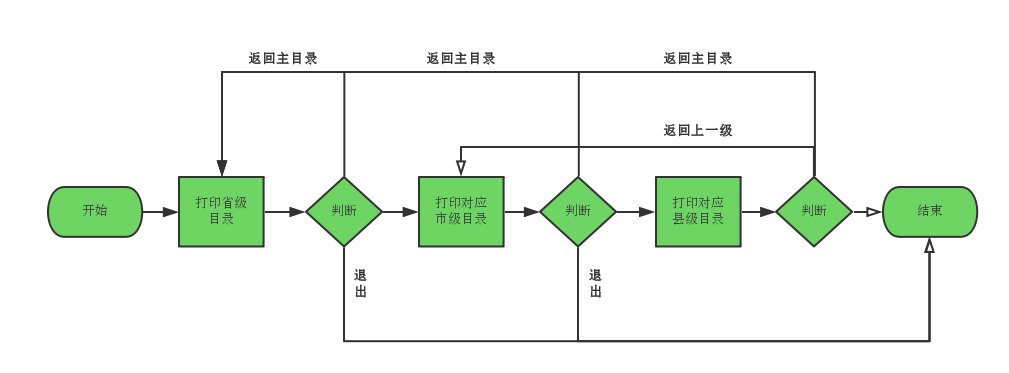Python基础进阶之数据类型
一、数据类型
Python3 中有六个标准的数据类型:
- Number(数字)
- String(字符串)
- List(列表)
- Tuple(元组)
- Sets(集合)
- Dictionary(字典)
Python3 支持 int(整形)、float(浮点型)、bool(布尔型)、complex(复数)。在Python 3里,只有一种整数类型 int,表示为长整型,没有 python2 中的 Long。布尔值:真或假,1 或 0。
二、列表
1.列表创建
>>> list = [1,2,3,4,5] >>> print(list) [1, 2, 3, 4, 5]
2.列表切片
list = [1,2,3,4,5]
>>> print(list)
[1, 2, 3, 4, 5]
>>> list[1:4] #取下标1至下标4之间的数字,包括下标1,不包括下标4
[2, 3, 4]
>>> list[1:-1] #取下标1至-1的值,不包括-1
[2, 3, 4]
>>> list[0:3]
[1, 2, 3]
>>> list[:3] #如果是从头开始取,0可以忽略,跟上句效果一样
[1, 2, 3]
>>> list[3:] #如果想取最后一个,必须不能写-1,只能这么写
[4, 5]
>>> list[:-1] #这样-1就不会被包含了
[1, 2, 3, 4]
>>> list[0::2] #后面的2是代表,每隔一个元素,就取一个
[1, 3, 5]
>>> list[::2] #和上句效果一样
[1, 3, 5]
3.列表追加
>>> list.append(6) >>> list [1, 2, 3, 4, 5, 6] #默认追加到最后面,要想往前面看下一个
4.列表插入
>>> list [1, 2, 3, 4, 5, 6] >>> list.insert(1,"插入到2前面") #默认插入到下标前面,元素2的下标是1 >>> list [1, '插入到2前面', 2, 3, 4, 5, 6] >>> list.insert(3,"插入到2后面") #2的下标变成了2,插入2的后面也就是往下标3的前面插入 >>> list [1, '插入到2前面', 2, '插入到2后面', 3, 4, 5, 6]
5.列表修改
>>> list [1, '插入到2前面', 2, '插入到2后面', 3, 4, 5, 6] >>> list[1]="下标一" >>> list[3]="下标三" >>> list [1, '下标一', 2, '下标三', 3, 4, 5, 6]
6.列表删除
>>> list
[1, '下标一', 2, '下标三', 3, 4, 5, 6]
>>> del list[1] #删除下标是1的元素
>>> list
[1, 2, '下标三', 3, 4, 5, 6]
>>> list.remove("下标三") #删除叫下标三的元素
>>> list
[1, 2, 3, 4, 5, 6]
>>> list.pop(5) #删除下标是5的元素
>>> list
[1, 2, 3, 4, 5]
>>> list.pop() #默认删除最后一个元素
>>> list
[1, 2, 3, 4]
7.列表扩展
>>> list [1, 2, 3, 4] >>> list + [5,6,7,8,9] [1, 2, 3, 4, 5, 6, 7, 8, 9] >>> list [1, 2, 3, 4] >>> list=list + [5,6,7,8,9] >>> list [1, 2, 3, 4, 5, 6, 7, 8, 9] >>> list2=[10] >>> list.extend(list2) >>> list [1, 2, 3, 4, 5, 6, 7, 8, 9, 10]
8.列表copy(浅copy和深copy)
>>> list [1, 1, 2, 3, 4, 5, 6, 7, 8, 9, 10] >>> list2=list.copy() >>> list2 [1, 1, 2, 3, 4, 5, 6, 7, 8, 9, 10]
>>> list [[0, 1], 1, 2, 3, 4, 5, 6, 7, 8, 9, 10] >>> list2=list.copy() >>> list2 [[0, 1], 1, 2, 3, 4, 5, 6, 7, 8, 9, 10] >>> list[0][1]="test" >>> list [[0, 'test'], 1, 2, 3, 4, 5, 6, 7, 8, 9, 10] >>> list2 [[0, 'test'], 1, 2, 3, 4, 5, 6, 7, 8, 9, 10] #当list改变,list2也同时发生了改变,copy只能copy第一层,深copy需要copy模块 >>> import copy >>> list3=copy.deepcopy(list) #深copy >>> list3 [[0, 0], '一', 2, 3, 4, 5, 6, 7, 8, 9, 10] >>> list[0][0]=666 >>> list [[666, 0], '一', 2, 3, 4, 5, 6, 7, 8, 9, 10] >>> list3 [[0, 0], '一', 2, 3, 4, 5, 6, 7, 8, 9, 10] #修改list后,未发生变化
9.列表统计
>>> list [1, 1, 2, 3, 4, 5, 6, 7, 8, 9, 10] >>> list.count(1) #统计1元素有几个 2
10.翻转和排序
>>> list [1, 1, 2, 3, 4, 5, 6, 7, 8, 9, 10] >>> list.reverse() #列表元素翻转 >>> list [10, 9, 8, 7, 6, 5, 4, 3, 2, 1, 1] >>> list.sort() #按照ASCII表进行排序 >>> list [1, 1, 2, 3, 4, 5, 6, 7, 8, 9, 10]
11.获取下标
>>> list [1, 2, 3, 4, 5, 6, 7, 8, 9, 10] >>> list.index(1) #元素1的下标 0
三、元组
组其实跟列表差不多,也是存一组数,只不是它一旦创建,便不能再修改,所以又叫只读列表。它只有2个方法,一个是index,一个是count。
>>> list = (0,1) >>> list.index(0) 0 >>> list.count(0) 1
四、字典
字典一种key - value 的数据类型,使用就像我们上学用的字典,通过笔划、字母来查对应页的详细内容。
字典的特性:
- dict是无序的
- key必须是唯一的
1.字典创建
>>> dict={'key1':'value1','key2':'value2'} #字典用的是大括号,列表是中括号,元组是小括号
>>> dict
{'key1': 'value1', 'key2': 'value2'}
2.字典增加
>>> dict['key3']='value3'
>>> dict
{'key3': 'value3', 'key1': 'value1', 'key2': 'value2'}
3.字典修改
>>> dict['key3']='value33333'
>>> dict
{'key3': 'value33333', 'key1': 'value1', 'key2': 'value2'}
4.字典删除(三种姿势)
>>> dict.pop("key3") #第一种姿势
'value33333'
>>> dict
{'key1': 'value1', 'key2': 'value2'}
>>> dict.popitem() #随机删除姿势
('key1', 'value1')
>>> dict
{'key2': 'value2'}
>>> del dict('key2') #注意,符号打错了,和上面的不一样
SyntaxError: can't delete function call
>>> del dict['key2'] #删除key2项
>>> dict
{}
5.字典查找
dict={'key1':'value1','key2':'value2'}
>>> 'key1' in dict #标准用法
True
>>> dict.get("key1") #获取
'value1'
>>> dict.get('key10') #如果没有这个key
>>> dict['key1'] #获取
'value1'
>>> dict['key10'] #如果没有这个key,报错
Traceback (most recent call last):
File "<pyshell#125>", line 1, in <module>
dict['key10']
KeyError: 'key10'
City_list = {
"北京":{
"海淀":['上地','清河'],
"昌平":['回龙观','沙河'],
},
"河北":{
"保定":['易县','定州'],
"石家庄":['新华区','桥西区'],
},
"辽宁":{
"沈阳":['皇姑区','铁西区'],
"大连":['瓦房店','普兰店'],
},
}
one=True
two=True
while one:
print("欢迎使用多级菜单,现在显示一级菜单:")
for i in City_list.keys():
print(" ",i)
first_input=input("请输入省级菜单名称打开市级菜单,按q退出,按b返回主菜单:")
if first_input == "q":
one=False
break
elif first_input == 'b':
break
else:
for k in (City_list[first_input].keys()):
print(" ",k)
while two:
second_input=input("请输入市级菜单名称打开县级菜单,按q退出,按b返回主菜单:")
if second_input == "q":
one=two=False
break
elif second_input == "b":
break
else:
for l in (City_list[first_input][second_input]):
print(" ",l)
third_input=input("执行完毕,按q退出,按b返回上一层,任意键返回主菜单:")
if third_input == "q":
exit()
elif third_input == "b":
continue
else:
for n in City_list.keys():
print(" ",n)
break
多级菜单程序
1 City_list = {
2 "北京":{
3 "海淀":['上地','清河'],
4 "昌平":['回龙观','沙河'],
5 },
6 "河北":{
7 "保定":['易县','定州'],
8 "石家庄":['新华区','桥西区'],
9 },
10 "辽宁":{
11 "沈阳":['皇姑区','铁西区'],
12 "大连":['瓦房店','普兰店'],
13 },
14 }
15 one=True
16 two=True
17 while one:
18 print("欢迎使用多级菜单,现在显示一级菜单:")
19 for i in City_list.keys():
20 print(" ",i)
21 first_input=input("请输入省级菜单名称打开市级菜单,按q退出,按b返回主菜单:")
22 if first_input == "q":
23 one=False
24 break
25 elif first_input == 'b':
26 break
27 else:
28 for k in (City_list[first_input].keys()):
29 print(" ",k)
30 while two:
31 second_input=input("请输入市级菜单名称打开县级菜单,按q退出,按b返回主菜单:")
32 if second_input == "q":
33 one=two=False
34 break
35 elif second_input == "b":
36 break
37 else:
38 for l in (City_list[first_input][second_input]):
39 print(" ",l)
40 third_input=input("执行完毕,按q退出,按b返回上一层,任意键返回主菜单:")
41 if third_input == "q":
42 exit()
43 elif third_input == "b":
44 continue
45 else:
46 for n in City_list.keys():
47 print(" ",n)
48 break

多级菜单流程图
